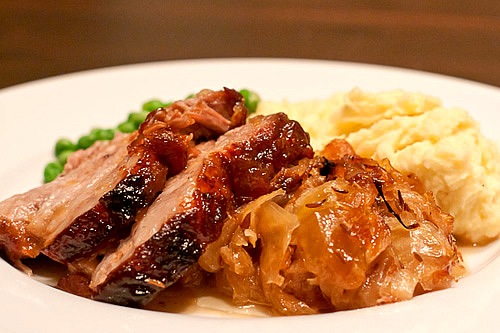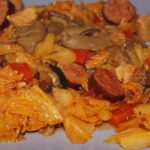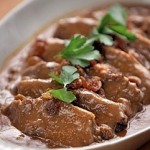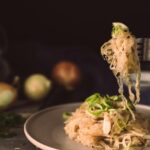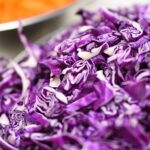The Comfort Dish That Defines German Cuisine
Few meals are as deeply rooted in German culinary tradition as Roast Pork and Sauerkraut. It’s the kind of dish that reminds you of family gatherings, village taverns, and festive Sunday lunches. With its irresistible combination of tender pork, tangy sauerkraut, and savory pan juices, this classic recipe is a testament to German cooking at its best – unpretentious, hearty, and nourishing.
Whether you’re preparing a feast for New Year’s Day (a lucky tradition in many German households) or just looking for a cozy dinner that warms from the inside out, this dish is a must-try. Let’s dive into the cultural history, ingredients, and step-by-step instructions to make Roast Pork and Sauerkraut at home.
The Origins of Roast Pork and Sauerkraut
This beloved combination comes from southern Germany, especially Bavaria and Rhineland-Palatinate, where pork and cabbage are staples of the regional diet. For centuries, sauerkraut served as a preserved vegetable during harsh winters, while pork – particularly from the shoulder or loin – was a favored meat for its richness and versatility.
Roast Pork and Sauerkraut became a celebratory dish often served on New Year’s Day, symbolizing prosperity and good fortune. The long, stringy nature of the cabbage is said to represent wealth (like paper money), and pork is associated with progress, as pigs “root forward” rather than backward.
You’ll also find this pairing during Oktoberfest and other regional festivals, often accompanied by potatoes, beer, and plenty of storytelling.
For more culturally rich dishes, see our German Sauerkraut Cheese Spätzle Recipe and German Sauerkraut Recipe Collection.
Ingredients for Authentic Roast Pork and Sauerkraut
For the Pork Roast:
-
2–3 lbs (1–1.5 kg) pork shoulder or pork loin (bone-in or boneless)
-
2 tbsp vegetable oil or lard
-
2 tsp salt
-
1 tsp ground black pepper
-
1 tbsp caraway seeds (optional)
-
1 tbsp sweet paprika
-
1 onion, sliced
-
2 cloves garlic, minced
-
1/2 cup chicken or beef broth
-
1/2 cup dry white wine or apple cider (optional)
For the Sauerkraut:
-
3 cups German sauerkraut (rinsed and drained)
-
1 apple, peeled and grated
-
1 small onion, finely chopped
-
1 tsp caraway seeds (optional)
-
1/2 cup broth or apple juice
-
1 tbsp sugar or honey (to balance acidity)
-
Salt and pepper to taste
How to Make Roast Pork and Sauerkraut (Step-by-Step)
Step 1: Preheat and Season
Preheat oven to 180°C (350°F). Pat the pork dry and rub it with salt, pepper, paprika, and caraway seeds. Let it rest at room temperature for 20 minutes while preparing the sauerkraut.
Step 2: Prepare the Sauerkraut Base
In a pan, heat a little oil and sauté chopped onion until translucent. Add the grated apple and cook for another 2 minutes. Stir in sauerkraut, caraway seeds, sugar, and broth or juice. Let simmer for 5 minutes, then set aside.
Step 3: Sear the Pork
In a large oven-safe pot or Dutch oven, heat oil or lard and sear the pork on all sides until golden brown (about 8–10 minutes total). Add sliced onion and garlic, cook for 1 minute more.
Step 4: Roast It All Together
Layer the sauerkraut mixture around the pork in the roasting pot. Pour in broth and wine (or cider). Cover tightly with a lid or foil and transfer to the oven.
Roast for 2–2.5 hours, basting with pan juices occasionally. For a crisper crust, uncover during the last 20 minutes of cooking.
Step 5: Rest and Serve
Let the pork rest for 10 minutes before slicing. Serve on a platter surrounded by sauerkraut, drizzled with pan juices, and paired with your favorite side dish.
Tip: Rinsing sauerkraut reduces sharpness. Keep some brine if you prefer stronger flavor. Use a meat thermometer to ensure the pork reaches 70°C (160°F) internally.
How to Serve Roast Pork and Sauerkraut
This dish is hearty enough to stand alone, but traditional German sides make it shine:
-
Boiled potatoes or creamy mashed potatoes
-
German-style potato salad with vinegar and bacon
-
Braised red cabbage for sweet contrast
-
Whole grain mustard on the side
-
Crispy rye rolls or pretzels for dipping into pan juices
Drink pairing: A glass of dry Riesling, Dunkel (dark lager), or apple cider brings out the richness of the roast and the brightness of the sauerkraut.
Variations & Regional Twists
-
Bavarian version: Adds beer instead of wine and includes cloves and juniper berries in the braising liquid.
-
Palatinate style: Uses a smoked pork neck or Kasseler and serves it with sauerkraut sweetened with apple.
-
Modern twist: Add fennel or roasted root vegetables to the roasting pan for extra depth.
Want a casserole-style dish with similar flavors? Try our Bratwurst Sauerkraut Casserole with Pretzels, or get creative with Sauerkraut Cheese Spätzle.
A German Classic Worth Mastering
Roast Pork and Sauerkraut is more than just a meal – it’s a connection to generations of German cooks who understood the magic of slow roasting and fermented flavors. Whether you’re celebrating a holiday or simply craving something warm and traditional, this dish is the perfect introduction to authentic German cooking.
Hungry for more? Explore our full collection of German Sauerkraut Recipes or learn how to pair pork with German Apple Sauerkraut for a sweet-savory twist.
Related Articles:
How Sauerkraut Became Germany’s Superfood
Learn how sauerkraut became Germany’s nutritional powerhouse. Discover its health benefits, cultural history, and delicious German recipes to try.
